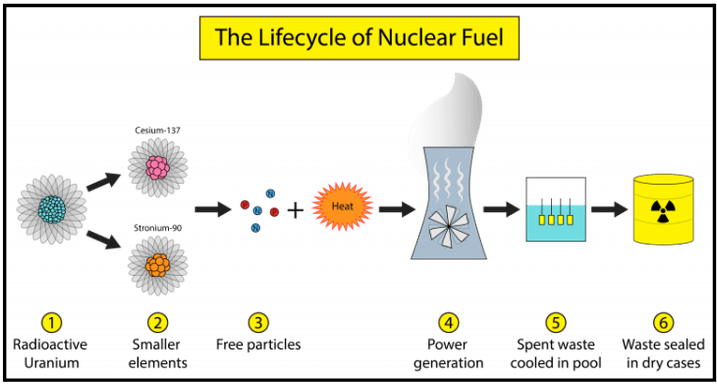GS Paper III
News Excerpt:
India recently advanced its nuclear program by loading the core of the Kalpakkam PFBR, nearing stage II of its nuclear programme. With stage III aimed at utilizing thorium reserves for energy, India faces the challenge of effective nuclear waste management amidst its nuclear power expansion.
What is nuclear waste?
- Nuclear waste refers to the radioactive materials produced during nuclear reactions in nuclear power plants, research reactors, nuclear weapons production, and other nuclear processes.
- In a fission reactor, neutrons bombard the nuclei of atoms of certain elements.
- When one such nucleus absorbs a neutron, it destabilises and breaks up.
- This process produces energy and creates nuclei of different elements.
- For example, when the uranium-235 (U-235) nucleus absorbs a neutron, it can fission to barium-144, krypton-89, and three neutrons. If the ‘debris’ (barium-144 and krypton-89) constitute elements that can’t undergo fission, they become nuclear waste.
- Nuclear waste is highly radioactive and needs to be stored in facilities reinforced to prevent leakage into and contamination of the local environment.
- Apart from the byproducts from nuclear fission reaction nuclear waste can come in various forms, including spent nuclear fuel rods, contaminated equipment and materials.
How do we handle nuclear waste
- Handling nuclear waste, particularly spent fuel, poses significant challenges due to its heat and radioactivity.
- Spent fuel is initially stored underwater for several decades before being transferred to dry casks for longer-term storage.
- Countries with nuclear power programs have accumulated substantial inventories of spent fuel, such as the U.S. (69,682 tonnes in 2015), Canada (54,000 tonnes in 2016), and Russia (21,362 tonnes in 2014).
- Storage periods for nuclear waste can extend up to millennia, requiring isolation from human contact for longer than modern humans have existed.
- Nuclear power plants also have liquid waste treatment facilities to manage aqueous wastes containing short-lived radionuclides.
- Depending on their hazard levels, liquid wastes may be discharged after treatment or processed through methods like evaporation, chemical precipitation, absorption on solid matrices, or incineration.
- Liquid high-level waste, containing most fission products produced in the fuel, is vitrified into a stable glass form for storage.
- In certain cases, such as in India's pressurized heavy-water reactors, where spent fuel is reprocessed, fission products that cannot be used as fuel must be stored as liquid waste, posing potential accident hazards.
How is nuclear waste dealt with?
- After spending at least a year in the spent-fuel pool for cooling, the spent fuel can be transferred to dry-cask storage.
- It is enclosed within substantial steel cylinders and surrounded by inert gas.
- These cylinders are securely sealed and then placed within larger chambers made of steel or concrete.
- Some experts have also rooted for geological disposal:
- The waste is sealed in “special containers” and buried underground in granite or clay.
- The upside here is long-term storage away from human activity.
- However, studies have highlighted the risk of radioactive material exposure if containers are disturbed, potentially through nearby excavation activities.
- Reprocessing, which involves separating fissile from non-fissile material in spent fuel, is another method for handling nuclear waste.
- First the material is chemically treated to separate fissile material left behind from the non-fissile material.
- Reprocessing facilities require specialized protections and personnel due to the hazardous nature of spent fuel.
- These facilities offer the advantage of higher fuel efficiency but come with significant expenses.
- Reprocessing also yields weapons-usable plutonium.
What are the issues associated with nuclear waste?
- The issues associated with nuclear waste include its long-term storage, potential for environmental contamination, health hazards from radiation exposure, the need for safe disposal methods, and societal concerns regarding transportation and storage security.
- Additionally, the management of nuclear waste involves significant costs and regulatory challenges, while the long-lasting radioactive nature of some materials poses challenges for future generations.
How does India handle nuclear waste?
- According to a 2015 report of the International Panel on Fissile Materials (IPFM), India has reprocessing plants in Trombay, Tarapur, and Kalpakkam.
- According to the PMO, the wastes generated at the nuclear power stations during the operation are of low and intermediate activity level and are managed at the site itself.
- Nuclear waste is treated and stored in on-site facilities.
- Such facilities are located at all nuclear power stations”, and that the surrounding area “is monitored for radioactivity” for safety.
Diagram:



